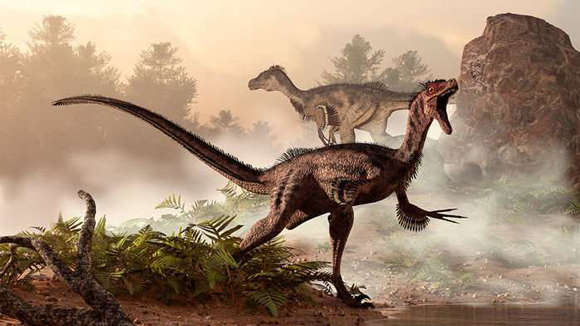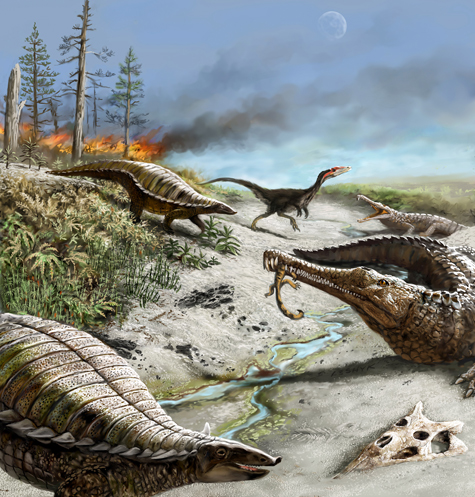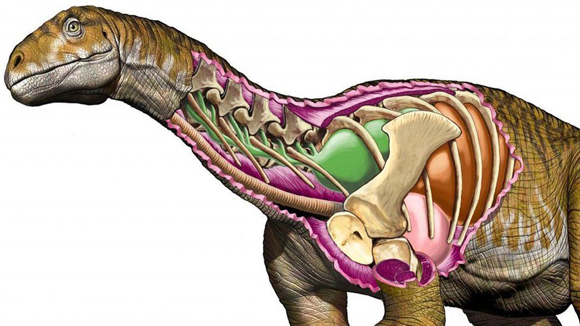Bird-like Lungs Could Have Helped Dinosaurs to Dominate
There has been a great deal of debate regarding the rise of the Dinosauria. How and when did these relatively unassuming members of the Dinosauria, which only made up a small proportion of terrestrial biota during the Middle Triassic, rise to dominance, out-competing a host of other reptilian groups? The respiratory system of dinosaurs could provide a clue. In a new study published in the open access journal of the Royal Society (Royal Society Open Science), a team of researchers postulate that the lung-air sac system could have helped dinosaurs thrive in Earth’s oxygen-depleted atmosphere.
Did a Super-efficient Pulmonary System Help the Dinosaurs to Thrive?

Picture credit: Chinese Academy of Sciences
Studying the Breathing Systems of Modern Birds and Alligators
Birds have a super-efficient respiratory system that is unique amongst the vertebrates. However, palaeontologists remain uncertain as to when the avian-style lung evolved. Did it evolve in dinosaurian ancestors or is it restricted to birds? After all, if you are going to fly, then you need a very efficient and powerful set of lungs to get enough oxygen to your flight muscles.
This area of anatomy has attracted a great deal of debate. Recently, Everything Dinosaur reported on a study conducted on a specimen of Archaeorhynchus spathula, a primitive bird (basal member of the Ornithuromorpha), from the Lower Cretaceous of China, that may show preservation of an advanced avian lung. To read more about this research: Breathing Life into the Bird Lungs Debate.
The scientists, including researchers from the University of Manchester, compared dinosaur lungs to those of living crocodilians and the lungs of extant birds. Lead researcher, PhD student Robert Brocklehurst (School of Earth and Environmental Sciences, Manchester University), stated:
“The respiratory system of non-avian dinosaurs has been the topic of considerable study over the years, both in an attempt to shed light on the biology of now extinct members of the dinosaur family, and in order to understand the origins and evolution of modern birds and reptiles.”
Low Oxygen Levels in the Triassic and Early Jurassic
Today, our atmosphere contains approximately 21 percent oxygen, however, things have not always been like that. During the Middle Triassic, through to the Early Jurassic, a time that saw the evolution and the radiation of the Dinosauria, the atmospheric oxygen percentage of our planet fell to around 15-17%. With less oxygen in the air, a group of vertebrates with more efficient lungs would have had a definite evolutionary advantage over other terrestrial animals.
During the Triassic A Wide Variety of Terrestrial Reptilian Vertebrates Co-existed

Picture credit: Victor Leshyk
Studying the Lungs of the Dinosauria
To investigate the different kinds of respiratory systems the team used Computerised Tomography (CT) scans to look at the lung cavities of four modern crocodilians and twenty-nine modern birds, including the largest living bird today, the ostrich and compared their structure with those of sixteen different dinosaur species. The detailed scans revealed that all the dinosaurs had vertebrae more similar in shape to those of birds than those of crocodilians. In addition, the scientists discovered that the dinosaur vertebrae jutted into the lung cavity, the same as found in living birds.
Robert explained:
“We thought some of the dinosaurs would have lungs more like birds, and others would be similar to reptiles, but this wasn’t the case at all. Every dinosaur sample we scanned just looked like the birds we scanned.”
Dissection Used in this Study
As well as using CT scans, the team removed the lungs of an alligator and an ostrich, and found the skeletal support structures surrounding the lungs were very different in each animal. The alligator’s lung cavity was smooth and allowed the lungs and other internal organs to glide as they move to pump air in and out while the animal swims. However, the ostrich lung cavity was found to be furrowed, similar to the anatomical condition found in the dinosaurs.
The scientists concluded that having more efficient bird-like lungs permitted the dinosaurs to adapt and thrive in an oxygen depleted environment, whereas other groups including the the Crurotarsi clade of archosaurs that gave rise to modern crocodiles, struggled.
Commenting on the research, co-author Professor Bill Sellers (Manchester University) added:
“If even the very first dinosaurs to evolve had bird-like lungs, this goes some way to explaining why dinosaurs became the dominant animal species of their time. Other animal groups simply may not have had lungs as well suited to extracting oxygen from the air. That simple evolutionary difference may have let dinosaurs rule world.”
An Anatomical Advantage for the Dinosauria
The scientists concluded that respiratory and pulmonary modifications would have provided dinosaurs with more efficient means of oxygen uptake relative to other vertebrates during the environmentally hypoxic conditions which pervaded much of the early part of the Mesozoic. This anatomical advantage enjoyed by the Dinosauria could thus potentially have contributed to their radiation and dominance over terrestrial ecosystems, which was to last for around 150 million years.
The Lungs of Dinosaurs Helped to Power Their Evolutionary Success

Picture credit: Jorge A. González
Everything Dinosaur acknowledges the assistance of a press release from Manchester University in the complilation of this article.
The scientific paper: “Vertebral Morphometrics and Lung Structure in Non-avian Dinosaurs” by Robert J. Brocklehurst, Emma R. Schachner and William I. Sellers published in Royal Society Open Science.
Visit the user-friendly Everything Dinosaur website: Everything Dinosaur.






Has the position of the 3 or 4 chambered heart relative to the lungs been ascertained?
Dinosaur anatomy remains quite poorly understood due to the lack of soft tissue preservation. There has been considerable research in this area, but for the Dinosauria a “one solution fits all” approach seems unlikely.This is because of the huge differences in individual genera represented by the clade. In the largest dinosaurs, the Sauropodomorpha the have been a number of hypotheses proposed as to how these enormous animals could have blood pressure high enough to support the pumping of blood up their long necks to their brains. Research suggests that in the case of these dinosaurs their flexible rib cage and the kinetic movement of their necks as they walked could have assisted with the circulation of blodd up their necks to the brains. In contrast, the Theropoda probably had pulmonary and circulatory systems similar to modern birds.